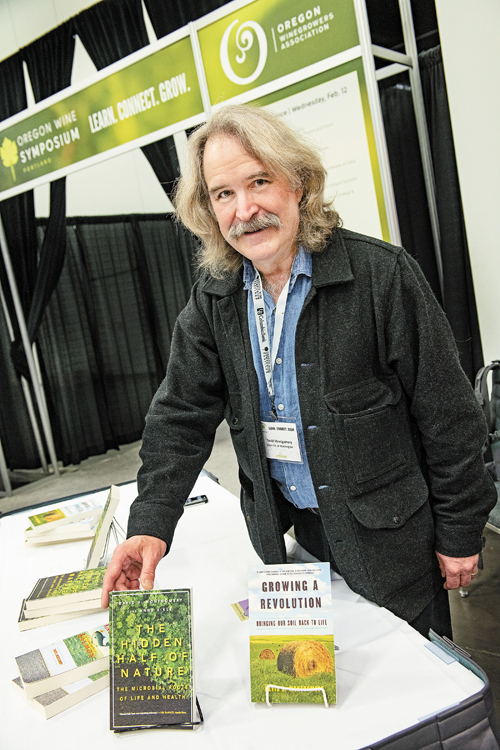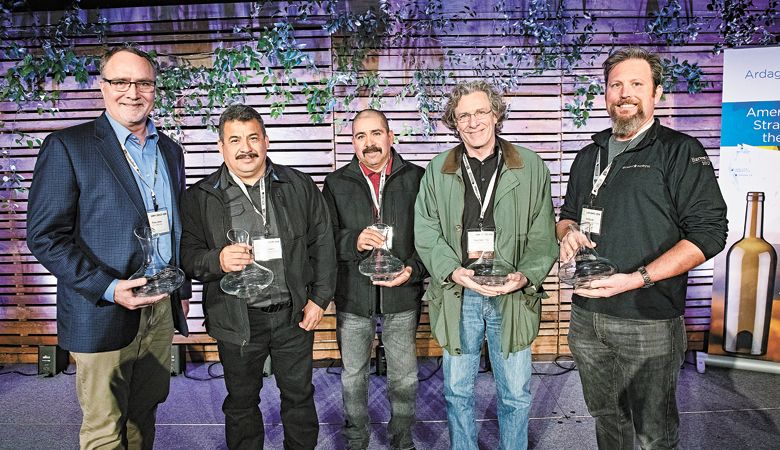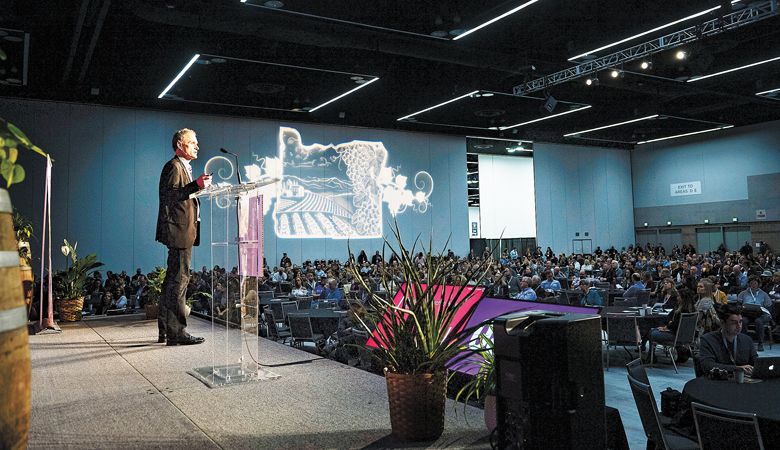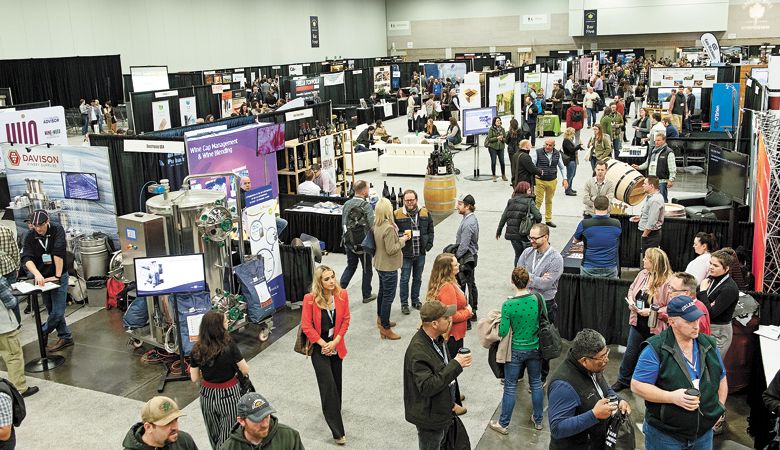Symposium 2020
Annual conference teaches, advises, honors
The Oregon Wine Symposium presented by the Oregon Wine Board and Oregon Winegrowers Association has become as perennial an occurrence as the vintage itself. Tradespeople from all corners of the state and beyond converge on the Oregon Convention Center in Portland for two dense days of seminars, roundtable discussions, educational tasting, awards and more.
Like the industry, the Symposium is formal on the surface but pretty casual at heart. It’s a healthy mix of buttoned-up sales reps and boot-clad vineyard crews and winemakers. It’s become a sanctuary for important data to be shared and now draws academics and presenters from all over the map.
This year, there were a few obvious themes. Many of the workshops touched on global warming, sustainability and the possibility of popularizing new varieties in a changing Oregon. The direct-to-consumer segments stressed social media and an evolving online landscape while the requisite trade area showed off current bottling options, tractors, falconer outfits and more.
Here some highlights from the 2020 Oregon Wine Symposium, held in the Rose City, Feb. 11 and 12.
Alternative Farming
At a joint viticulture and enology session, Brian Gruber, a winegrower in Southern Oregon, and climate scientist Dr. Greg Jones and others talked about farming amid the changing climate. The session painted a vivid image of the current landscape, one where famous regions like Bordeaux are editing their approved in-appellation varieties to account for warmer temperatures.
The speakers offered diversity as one possible solution to the issue at hand. Whether grafting in the vineyard or blending in the cellar, a variety of grape options provides a safety net, not to mention a means for seeing what might do especially well in the future. Eola Springs Vineyard provided a glimpse of what future Willamette Valley vineyards might look like in their adaption — a mix of expected blue-chip varieties like Pinot Noir and Chardonnay along with emerging options like Cab Franc and Muscat.
Powdery Mildew
In the wake of a 2019 vintage that delivered more mold than usual — as of late — it was no surprise that powdery mildew took center stage. In the Willamette Valley, especially, growers continue to grapple with the fungal disease. A session moderated by longtime viticulturist Leigh Bartholomew discussed means of managing the pest, along with mildew details earned for more and more vintages under the industry’s collective belt.
“[The growing season of ] 2019 reminded us that Mother Nature holds the upper hand,” Bartholomew says. The panel spotlighted research done in detecting the disease with the use of spore traps as well as a store-bought pair of rubber gloves. While powdery mildew’s lifespan is relatively short at roughly five-days, it has the ability to overwinter in vineyards. It’s also more of a problem because, quite simply, there’s more of it out there floating about.
Data alongside weather patterns, pushing bloom and harvest forward, dealt a strong conclusion: Start managing mildew early and often.
Harvest Sweet Spot
A session on when to pick offered some useful intel on what many believe is the most critical decision a winemaker makes. Many of the usual criteria were discussed — analytics like Brix and pH — but a few other interesting factors pushed to the fore. Winemakers like Geoff Hall of Argyle and Anna Welch Prost of A to Z talked about things like air quality and logistics, as in the ability to obtain labor or space in the cellar of incoming fruit.
The most fascinating element of the seminar came from Cecilia Cunningham, a consultant with a lengthy background in sensory analysis. She discussed the sugar load of individual berries as opposed to the traditional Brix method, which measures sweetness via density. The method she championed had been tried in vineyards throughout the globe and seemed to offer a clearer picture about exactly when to harvest.
Whereas a Brix reading can become fuzzy just before picking — revealing increased sweetness when, in fact, it’s just being concentrated in a smaller berry — the sugar load method takes into account a key moment when the fruit stops generating sugar. Expect to see info and studies revealed about this technique down the line.

Carbon Farming
If there’s a rock star in the geology field, it might be Dr. David Montgomery. The author and University of Washington professor delivered one of the most entertaining lectures of the Symposium, tackling what he described as the “fifth revolution of agriculture.”
“We need to change agriculture this century if we want to feed people next century,” Montgomery says. The main villain in this story? The till. Montgomery, like a growing number of scientists and agriculture experts, is pushing for regenerative farming that boosts soil health as opposed to disturbing it and stripping it of its natural wealth.
The theme was conservation agriculture, which depends on essential tenets like little to no manual disturbance of the earth, cover crops and a diversity of crop rotations to fend off pathogens and keep them from carrying over. Here, the panel touched on something many in the industry have known for a while but is just not getting some attention: Terroir is as much, or more, about microbial environment than it is about the things above ground — climate, elevation, etc.
Things began grim, with stats about the year-to-year depleting food capacity of the planet thanks to the erosion that comes from traditional farming. But, as Montgomery enthusiastically reported, there’s lots to be excited about should we change our ways. In a lot of indirect ways, his presentation praised what’s already being done by key parts of the industry, per organizations like LIVE or the Biodynamic movement.
Also a positive note, Montgomery shed some light on his own research in larger-scale farming away from wine country. He revealed promising figures suggesting that this kind of farming is not only more profitable than tilling, but requires fewer inputs and is much easier on the environment. It’s being embraced by farmers from the American Midwest to Africa.
Honors
It’s not a Symposium without a proper awards ceremony. This year, several industry leaders were recognized for their valuable work. Steve Robertson, founder of SJR Vineyard and Delmas Wines in The Rocks District of Milton-Freewater was honored with the Industry Leadership prize. “The Northwest is so young and has so much to learn,” a thankful Robertson remarked. “How cool is that?”
Dr. Greg Jones received the Industry Partner award for his climate research; while Vineyard Excellence awards went to standout field stewards Nahum Bahena of Stirling Wine Grapes and Moises Sotelo of NewGen Vineyard Services. A Founders award was presented to Southern Oregon icon Herb Quady, known widely for his Rhône varietals and immaculate Applegate Valley fruit.













